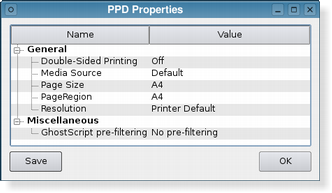PySide6.QtPrintSupport.QPrintDialog¶
- class QPrintDialog¶
The
QPrintDialogclass provides a dialog for specifying the printer’s configuration.Details
Warning
This section contains snippets that were automatically translated from C++ to Python and may contain errors.
The dialog allows users to change document-related settings, such as the paper size and orientation, type of print (color or grayscale), range of pages, and number of copies to print.
Controls are also provided to enable users to choose from the printers available, including any configured network printers.
Typically,
QPrintDialogobjects are constructed with aQPrinterobject, and executed using theexec()function.printDialog = QPrintDialog(printer, parent) if printDialog.exec() == QDialog.Accepted: # print ...
If the dialog is accepted by the user, the
QPrinterobject is correctly configured for printing.

The printer dialog (shown above in Plastique style) enables access to common printing properties. On X11 platforms that use the CUPS printing system, the settings for each available printer can be modified via the dialog’s Properties push button.
On Windows and macOS, the native print dialog is used, which means that some QWidget and QDialog properties set on the dialog won’t be respected. The native print dialog on macOS does not support setting printer options, i.e.
setOptions()andsetOption()have no effect.In Qt 4.4, it was possible to use the static functions to show a sheet on macOS. This is no longer supported in Qt 4.5. If you want this functionality, use
open().See also
Synopsis¶
Properties¶
optionsᅟ- The various options that affect the look and feel of the dialog
Methods¶
def
__init__()def
exec_()def
open()def
options()def
setOption()def
setOptions()def
testOption()
Signals¶
def
accepted()
Note
This documentation may contain snippets that were automatically translated from C++ to Python. We always welcome contributions to the snippet translation. If you see an issue with the translation, you can also let us know by creating a ticket on https:/bugreports.qt.io/projects/PYSIDE
Note
Properties can be used directly when
from __feature__ import true_propertyis used or via accessor functions otherwise.- property optionsᅟ: Combination of QAbstractPrintDialog.PrintDialogOption¶
This property holds the various options that affect the look and feel of the dialog.
By default, all options are disabled.
Options should be set before showing the dialog. Setting them while the dialog is visible is not guaranteed to have an immediate effect on the dialog (depending on the option and on the platform).
See also
- Access functions:
Constructs a print dialog with the given
parent.Constructs a new modal printer dialog for the given
printerwith the givenparent.This signal is emitted when the user accepts the values set in the print dialog. The
printerparameter includes the printer that the settings were applied to.- exec_()¶
- Return type:
int
Opens the dialog and connects its
accepted()signal to the slot specified byreceiverandmember.The signal will be disconnected from the slot when the dialog is closed.
- options()¶
- Return type:
Combination of
PrintDialogOption
See also
Getter of property
optionsᅟ.- setOption(option[, on=true])¶
- Parameters:
option –
PrintDialogOptionon – bool
Sets the given
optionto be enabled ifonis true; otherwise, clears the givenoption.See also
- setOptions(options)¶
- Parameters:
options – Combination of
PrintDialogOption
See also
Setter of property
optionsᅟ.- testOption(option)¶
- Parameters:
option –
PrintDialogOption- Return type:
bool
Returns
trueif the givenoptionis enabled; otherwise, returns false.See also